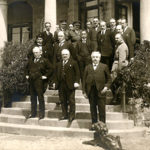Published April 6, 2006
Claremont Review of Books Spring, 2006 (Vol VI, No 2)
Freakonomics: A Rogue Economist Explores the Hidden Side of Everything,
by Steven D. Levitt and Stephen J. Dubner. HarperCollins, 256 pages, $25.95
According to Freakonomics, co-authored by University of Chicago economist Steven Levitt and freelance journalist Stephen Dubner, “economics is a science with excellent tools for gaining answers but a serious shortage of interesting questions.” This book, and its authors, have become well-known for asking all kinds of interesting questions. Do real estate agents act in their clients’ best interests? Why do so many drug dealers live with their mothers? Does campaign money determine election results?
Levitt and Dubner’s publisher proposed the book (and since then, a magazine column, blog, audio book, T-shirts, etc.) to capitalize upon a 2003 New York Times Magazine article Dubner had written about Levitt. Back then, Dubner quoted Levitt as saying, “I just don’t know very much about the field of economics. I’m not good at math, I don’t know a lot of econometrics, and I also don’t know how to do theory.” But once a media maelstrom erupted over the book’s assertion that legalized abortion has led to a reduction in crime, Levitt was forced to buttress the argument with his authority, telling the New York Times, for example, “As an economist, I am better than the typical person at figuring out whether abortion reduces crime….” Meanwhile, the book ignored the fatal weakness in his earlier research.
That original paper, co-authored with John J. Donohue, had many flaws, as economists have pointed out ever since Levitt posted it on the Internet in 1999. The paper argued that after abortion was legalized by several states starting in the late 1960s and nationwide by Roe v. Wade(1973), millions of fetuses were killed who, when old enough, would have been disproportionately likely to commit crimes. Abortion’s culling of them should therefore have lowered crime rates. To prove this, Levitt and Donohue looked at crime rates 15-18 years after Roe and found the drop they had predicted. But did abortion cause it? Many economists doubt it, pointing out, for example, that teenage crime soared in the late 1980s and early 1990s, just when the abortions’ effect should have manifested itself. But the paper examined only aggregate crime rates, not crime rates by age group.
Tellingly, Levitt and Donohue found their results indistinguishable whether they used 1970s or 1990s abortion rates to try to explain overall ’90s crime rates. But when both were included the models went statistically haywire (“standard errors explode due to multicollinearity”). This alarm goes off when research is “misspecified,” typically by omitting necessary variables. Failing to uncover any valid evidence for either a 20-year lag or for no lag, the two replaced the missing facts with an arbitrary assumption: “Consequently, it must be recognized that our interpretation of the results relies on the assumption that there will be a fifteen-to-twenty year lag before abortion materially affects crime.”
They justified their assumption by quipping that “infants commit little crime.” But nearly all violent crime is committed by men (women are equal only in nonviolent crime) precisely the ages of the fathers of aborted children. In short, the missing variable is “economic fatherhood.” (“Economic” fatherhood is defined not by residency with but by provision for one’s children.) Including this variable not only invalidates Levitt’s claim but reverses it. One can see this in a comparison of homicide rates and economic fatherhood, the latter defined by the Total Fertility Rate for the same demographic mix as prisoners (though measured for women, it’s almost exactly the same for men) minus men in prison (who cannot provide for children) and children on welfare (who aren’t supported by fathers). Though strong for all categories of crime, the trade-off with economic fatherhood strengthens with the crime’s violence, and is strongest for the most violent of all, homicide.
 |
|
(Click to enlarge.) |
As far back as data exist, rates of economic fatherhood and homicide have been strongly, inversely “cointegrated” — a stringent statistical test characterizing inherently related events, like the number of cars entering and leaving the Lincoln Tunnel. Legalizing abortion didn’t lower homicide rates 15-20 years later by eliminating infants who might, if they survived, have become murderers: it raised the homicide rate almost at once by turning their fathers back into men without dependent children — a small but steady share of whom do murder. The homicide rate rose sharply in the 1960s and ’70s when expanding welfare and legal abortion sharply reduced economic fatherhood, and it dropped sharply in the ’90s partly due to a recovering birth rate, but mostly because welfare reform and incarceration raised the share of men outside prison who were supporting children.
This scenario didn’t occur to Levitt not because of a lack of ingenuity or data but because of the inherent weakness of the theory he was trying to apply, which Nobel Prize-winning economists George J. Stigler and Gary S. Becker, Levitt’s mentor, called the “economic approach to human behavior.” Levitt was unable to see the true correlation between abortion and crime because he was among the first victims of an epic change in the teaching of economics orchestrated by Stigler, with Becker’s support.
Freakonomics relies heavily upon the theory of “information asymmetry,” which explains for example why a new car’s value drops sharply the moment it is driven off the lot (people assume that if anyone wants to resell a new car, it must be a lemon). Levitt and Dubner warn, “Experts — from criminologists to real-estate agents — use their information to serve their own agenda.” They don’t mention that Stigler and Becker viewed the teaching of economics exactly the same way. Stigler’s 1983 Nobel address advised his peers to consider themselves so many used-theory salesmen, whose livelihood was mortally threatened by students’ knowledge that newer (or older) theories are superior:
Gary Becker has suggested that…the established scholar possesses a valuable capital asset in his command over a particular body of knowledge. That capital would be reduced if his knowledge were made obsolete by the general acceptance of a new theory. Hence, established scholars should, in their own self-interest, attack new theories, possibly even more than they do in the absence of joint action.
For Stigler, this was not hypothetical. Until the mid-1950s, he had built his reputation as an expert in the history of economics on the strength of an excellent dissertation published in 1941, which covered 19th-century theory and had proceeded on the general assumption that economics began with Adam Smith. But Joseph Schumpeter’s History of Economic Analysis, published posthumously in 1954, demonstrated that all modern theory could be traced to the Scholastics who sifted and synthesized Biblical and Greco-Roman thought in light of Arabic and Jewish commentaries, and that “the Wealth of Nations does not contain a single analytic idea, principle, or method that was entirely new in 1776.” This fact revolutionized the field, but slashed Stigler’s relative expertise. He quickly switched from the history of economics to its modern sociology and urged others to do likewise. In a famous 1969 article he posed the question, “Does Economics Have a Useful Past?” and answered in the negative, explicitly opposing Schumpeter. In 1972, the University of Chicago’s economics department approved Stigler’s motion to abolish the requirement that students master its history before receiving a degree, and departments at all major universities quickly followed suit.
But Stigler was wrong in claiming “all that is useful and valid in earlier work is present — in purer and more elegant form — in the modern theory.” Economics has been taught at the highest university level since about 1250, when Thomas Aquinas integrated four theories from Aristotle and Augustine into a coherent whole: production; utility, which explains consumption; exchange; and final distribution, which explains personal gifts and crimes (as well as distributive justice in the family and government). All major economic thinkers taught the scholastic outline until Adam Smith.
Smith rejected the theories of utility and final distribution in The Theory of Moral Sentiments (substituting his famous “invisible hand”) and started classical economics with the outline chopped from four elements to two, production and exchange. The current neoclassical period began in 1870 when three economists dissatisfied with Smith’s revision (W.S. Jevons, Carl Menger, and Leon Walras) independently rediscovered the theory of utility. Since later neoclassical economists never reinvented final distribution, today’s theory contains no more than three elements — consumption, production, and exchange — and tries to explain final distribution with these three. This is why Levitt couldn’t reach a statistically valid conclusion about abortion and crime: he was trying to explain four things with only three explanatory equations.
Becker earned his 1992 Nobel Prize for building on Theodore Schultz’s rediscovery of Aristotle’s theory of the household production of so-called “human capital.” But on Stigler’s advice, Becker combined it with Jeremy Bentham’s incompatible notion that utility is a thing, a quantum of physiological pleasure that Bentham supposed is the ultimate good we all wish to consume. In Benthamite theory, all of us are selfish, sociopathic utility maximizers — freaks, as it were.
As Augustine explained 14 centuries before Bentham, utility is not a thing, but a relation: our order of preference (first, second, third, etc.) for the goods we want to distribute among the persons (including ourselves) who are the “end” or purpose of our actions. Our fundamental preference (also first, second, third, etc.) is for these persons, and we distribute our goods proportionally to our love for others relative to ourselves. This theory explains the near-perfect trade-off between homicide and economic fatherhood. Since parents spend so much time serving their children, they have less for themselves. A small but roughly constant fraction of all adult time spent on oneself is spent harming others. Hence for a few men, the choice is literally between giving life and taking it.
Historian Henry William Spiegel remarked of the “marginal revolution,” which ended classical economics and began the current neoclassical phase: “Outsiders ranked prominently among the pioneers of marginal analysis because its discovery required a perspective that the experts did not necessarily possess.” This will be true in coming decades as economists who understand the “human approach to economic behavior” of Aristotle, Augustine, and Aquinas find full employment rewriting neoclassical theories of the Bentham-Becker variety.
—John D. Mueller is author of Redeeming Economics: Free Markets and the Human Person (ISI Books), director of the Economics and Ethics program at the Ethics and Public Policy Center, and president of LBMC LLC, a financial-market forecasting firm.












